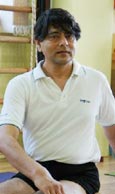The message from BKS Iyengar has always been twofold: align the pose and let consciousness come. For some such as me, however, learning alignment has been such a task that finding awareness of consciousness has been even more elusive than the turn of a femur. At some point, I gave up even trying.
 To the San Diego yoga conference named for the universality of yoga, senior Iyengar teacher Birjoo Mehta brought us a how-to message, a map any individual can follow to find that consciousness in a pose.
To the San Diego yoga conference named for the universality of yoga, senior Iyengar teacher Birjoo Mehta brought us a how-to message, a map any individual can follow to find that consciousness in a pose.
The good news: We should worry less about making corrections in a pose. The bad news: We have to use our minds even more than we use our bodies. As another senior Iyengar teacher, Manouso Manos, often notes: Finding resolution with the physical body is considerably less threatening.
Birjoo sets out the process in a pragmatic fashion, likening it to a corporative initiative.
What is the vision of yoga? Perceiving our permanent form.
What is the mission of yoga practitioners? Stilling the fluctuations of thought – in order to perceive our true, unchanging self.
What is the strategy for accomplishing our mission? Asana.
What tactics shall we use in our strategy? Alignment.
Birjoo Mehta
Birjoo lept lightly to the stage the first evening of the conference, Sarvabhauma Yog, which ran June 10-15, including the teachers convention.
A student of BKS Iyengar’s since childhood, starting in 1974, as a young man he traveled with his teacher through Europe, the United States and Australia, demonstrating poses. Now an engineer by profession, he has led conventions in the United Kingdom since 2001. When BKS Iyengar traveled to China in June 2011, Birjoo Mehta taught the evening sessions, though often with further guidance from his teacher.
Like his teacher, he brings joy to his teaching. In San Diegl, he made us laugh with implied threats of long holds of kapotasana. His hands wove like birds as he spoke. He smiled, he coaxed, he reached for analogies to help us understand that he wanted us to concentrate on consciousness, not the turn of a thigh.
With precision, he demonstrated the subtle actions he sought, wearing the banded shorts popular among Iyengar teachers and a polo-collared shirt also common among the male teachers.
Tadasana – Samasthiti
This pose is like the unchanging self at the center of all our fluctuations. It is the touchstone, the place of quiet at the center of a practice. The other poses all become variations. The key to envisioning this is in the name samasthiti: sama – same; sthiti – steadiness.
To find the quiet within fluctuations of other poses, Birjoo directed us to bring an element of tadasana to each pose.
In utthita trikonasana, Birjoo suggested we maintain the back leg actions of tadasana in both front and back legs as we slowly lowered into the pose. A surprising kind of steadiness resulted; a quiet, unfluctuating mind translated to a pose that felt grounded.
In bharadvajasana, once we had turned the torso, Birjoo asked us to recreate the evenness of torso found in tadasana. Once again quietness descended.
We touch back to universality when we bring samasthiti to other poses.
Balancing consciousness
For any other physical activity, the movement itself is the point. In yoga, the asana starts when the activity and movement of creation stops. We pay attention to the details of the pose as we create it, then, once in the pose, we let awareness move to where consciousness is. Then we seek to balance the consciousness throughout the pose.
In all the asymmetrical standing poses, consciousness concentrates in one leg or the other. Birjoo outlined this process in utthita trikonasana, where the back leg becomes light, with consciousness concentrated in the front leg. He suggested moving the bones where consciousness, density remained, and to move from the flesh to bring consciousness to the pose where it was light, such as the back leg.
Another consciousness balancing technique works through awareness of opposites. He suggested that where the flesh was puffed out or extended, excess consciousness existed. On the opposite side was an interruption of consciousness. To balance consciousness, we had to reopen that interruption. For example, a locked elbow produces excess consciousness along the inner elbow, and we must release the back side of the elbow to create evenness.
It all seemed accessible while he explained these concepts, which other teachers echoed in many other sessions. The trick is going to be in carrying it home with us, to apply his clarity of purpose to our practice.

To Tally: I very much enjoyed looking at your site, which indicates your studio very much shares my appreciation for Iyengar yoga. I am honored at your request and happy to agree to your sharing this post.
Very interesting post. With your permission, I would like to use/copy it on our website with a reference to this blog.
Thank you,
Tally